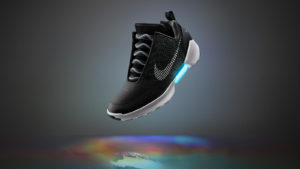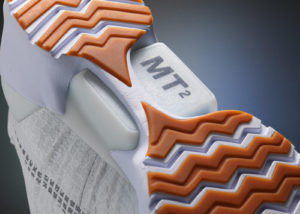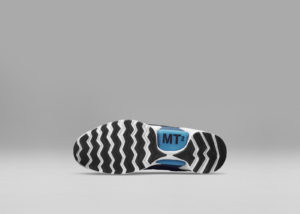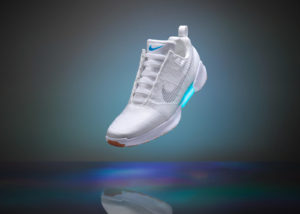
“Innovation at Nike is not about dreaming of tomorrow. It’s about accelerating toward it,” says Tinker Hatfield. “We’re able to anticipate the needs of athletes because we know them better than anybody. Sometimes, we deliver a reality before others have even begun to imagine it.”
Welcome the Nike HyperAdapt 1.0, the first performance vehicle for Nike’s latest platform breakthrough, adaptive lacing. The shoe translates deep research in digital, electrical and mechanical engineering into a product designed for movement. It challenges traditional understanding of fit, proposing an ultimate solution to individual idiosyncrasies in lacing and tension preference.
Functional simplicity reduces a typical athlete concern, distraction. “When you step in, your heel will hit a sensor and the system will automatically tighten,” explains Tiffany Beers, Senior Innovator, NIKE, Inc., and the project’s technical lead. “Then there are two buttons on the side to tighten and loosen. You can adjust it until it’s perfect.”
For Hatfield, the innovation solves another enduring athlete-equipment quandary: the ability to make swift micro-adjustments. Undue pressure caused by tight tying and slippage resulting from loose laces are now relics of the past. Precise, consistent, personalized lockdown can now be manually adjusted on the fly. “That’s an important step, because feet undergo an incredible amount of stress during competition,” he says.
Beers began pondering the mechanics shortly after meeting Hatfield, who dreamed of making adaptive lacing a reality. He asked if she wanted to figure it out — not a replication of a preexisting idea but as “the first baby step to get to a more sophisticated place.” The project caught the attention of a third collaborator, NIKE, Inc. President & CEO Mark Parker, who helped guide the design.
The process saw Beers brainstorming with a group of engineers intent on testing her theories. They first came up with a snowboard boot featuring an external generator. While far from the ideal, it was the first of a series of strides toward Beers and Hatfield’s original goal: to embed the technical components into such a small space that the design moves with the body and absorbs the same force the athlete is facing.


Through 2013, Hatfield and Beers spearheaded a number of new systems, a pool of prototypes and several trials, arriving at an underfoot-lacing mechanism. In April 2015, Beers was tasked with making a self-lacing Nike Mag to celebrate the icon’s true fictional release date of October 21. The final product quietly debuted Nike’s new adaptive technology. Shortly after, the completion of the more technical, sport version they’d originally conceived, the Nike HyperAdapt 1.0, confirmed the strength of the apparatus.
“It’s a platform,” Beers says, “something that helps envision a world in which product changes as the athlete changes.”
The potential of adaptive lacing for the athlete is huge, Hatfield adds, as it would provide tailored-to-the-moment custom fit. “It is amazing to consider a shoe that senses what the body needs in real-time. That eliminates a multitude of distractions, including mental attrition, and thus truly benefits performance.”


He concludes, “Wouldn’t it be great if a shoe, in the future, could sense when you needed to have it tighter or looser? Could it take you even tighter than you’d normally go if it senses you really need extra snugness in a quick maneuver? That’s where we’re headed. In the future, product will come alive.”
In short, the Nike HyperAdapt 1.0 is the first step into the future of adaptive performance. It’s currently manual (i.e., athlete controlled) but it makes feasible the once-fantastic concept of an automated, nearly symbiotic relationship between the foot and shoe.
The first generation of the HyperAdapt 1.0 will be available in the U.S. from November 28. The retail price is $720.00.
Source: nike.com